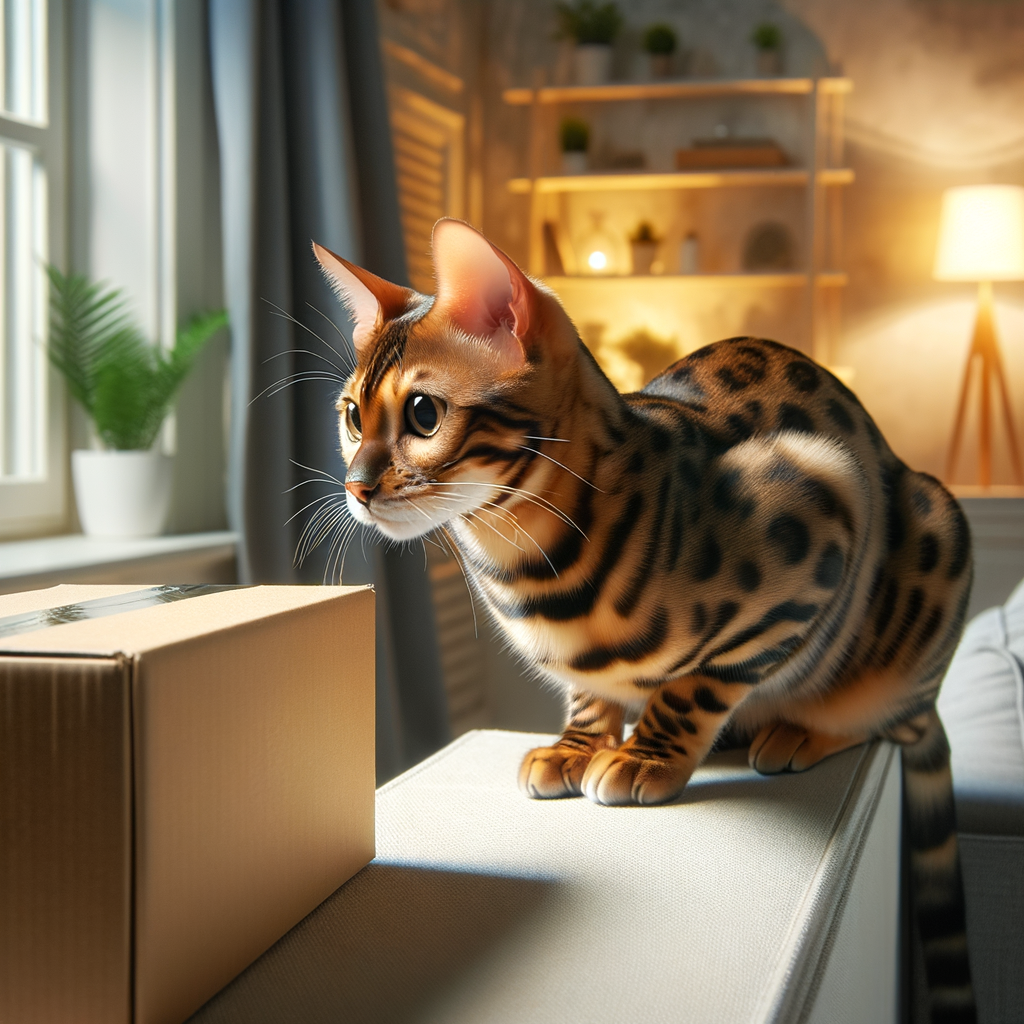
Introduction to Bengal Cat Behavior
- Overview of Bengal Cat Personality
Bengal cats are known for their playful and energetic nature. They love to explore and are very curious. These cats are also very social and enjoy spending time with their human families. Unlike some other breeds, Bengals are not typically shy and are often quite confident.
-
Key Characteristics of Bengal Cat Temperament
- Active: Bengals are very active and need plenty of exercise. They enjoy climbing and playing with toys.
- Intelligent: These cats are very smart and can learn tricks. They enjoy puzzle toys that challenge their minds.
- Affectionate: Bengals form strong bonds with their owners. They often follow their humans around the house and enjoy being involved in family activities.
- Vocal: Bengals are known to be quite vocal. They communicate with a variety of sounds, including meows, chirps, and purrs.
Bengal Cat Reactions to Environmental Changes
Changes in Physical Environment
- Bengal cat response to change in home layout:Bengal cats are very sensitive to changes in their home layout. Moving furniture or adding new items can make them feel uneasy. They might hide or become more vocal. Introduce changes slowly. Give your Bengal cat time to explore and get used to the new setup.
- Impact of outdoor environment changes on Bengal cat behavior:Changes in the outdoor environment, like new plants or structures, can also affect Bengal cats. They might become curious or anxious. If you have an outdoor space for your Bengal cat, make sure it is safe and familiar. Gradual changes help them adjust better.
Changes in Social Environment
-
Introduction of New Pets and Bengal Cat Reactions
Introducing a new pet can be exciting but also challenging for your Bengal cat. These cats are known for their strong personalities and territorial nature.
When a new pet enters the home, a Bengal cat may feel threatened. This can lead to behaviors like hissing, hiding, or even aggression.
To help your Bengal cat adjust, introduce the new pet slowly. Allow them to sniff each other through a barrier at first. Gradually increase their time together while supervising closely.
Providing separate spaces for each pet can also reduce stress. Make sure each has its own food, water, and litter box.
-
Changes in Family Dynamics and Bengal Cat Stress
Changes in family dynamics, such as a new baby or a family member moving out, can also affect your Bengal cat. These cats thrive on routine and can become stressed when their environment changes.
Signs of stress in Bengal cats include excessive grooming, loss of appetite, and unusual vocalizations. Monitor your cat’s behavior during these times.
To help your Bengal cat cope, try to maintain a consistent routine. Spend quality time with your cat to reassure them. Interactive toys and puzzles can also keep them engaged and reduce anxiety.
In some cases, consulting a veterinarian or a pet behaviorist may be necessary to manage severe stress.
Bengal Cat Stress and Anxiety
Signs of Stress in Bengal Cats
- Physical signs of stress in Bengal cats:
- Changes in Appetite: A stressed Bengal cat might eat less or more than usual.
- Excessive Grooming: If your cat is grooming too much, it could be a sign of stress.
- Weight Loss: Losing weight without a clear reason can indicate stress.
- Digestive Issues: Stress can cause vomiting or diarrhea in Bengal cats.
- Behavioral changes indicating stress in Bengal cats:
- Increased Aggression: A stressed cat may become more aggressive towards people or other pets.
- Hiding: If your Bengal cat is hiding more than usual, it could be feeling anxious.
- Changes in Litter Box Habits: Stress can lead to urinating or defecating outside the litter box.
- Vocalization: Excessive meowing or yowling can be a sign of stress.
Managing Bengal Cat Anxiety
-
Techniques to Reduce Bengal Cat Anxiety
- Provide a Safe Space: Ensure your Bengal cat has a quiet, safe area where they can retreat when feeling stressed.
- Interactive Play: Engage your cat with interactive toys and games. This helps to distract them and reduce anxiety.
- Calming Products: Use calming sprays or diffusers designed for cats. These products release pheromones that can help soothe your cat.
- Regular Exercise: Regular physical activity can help reduce stress. Play with your Bengal cat daily to keep them active and happy.
- Consistent Feeding Schedule: Maintain a regular feeding schedule. Predictability can help reduce anxiety.
-
Importance of Routine in Managing Bengal Cat Stress
- Predictability: A consistent routine helps your cat know what to expect, reducing uncertainty and stress.
- Stability: Regular routines provide a sense of stability, which is comforting for Bengal cats.
- Feeding Times: Feeding your cat at the same times each day can help regulate their internal clock and reduce anxiety.
- Play and Rest: Schedule playtime and rest periods consistently. This helps your cat balance their energy levels and stay calm.
Bengal Cat Adaptation to Changes
Adaptation Process
- Stages of Bengal cat adaptation to changes:
| Stage | Description |
|---|---|
| Initial Reaction | Bengal cats may feel scared or anxious when first encountering a change. |
| Exploration | They start exploring the new environment or situation cautiously. |
| Adjustment | Gradually, they begin to adjust and feel more comfortable. |
| Acceptance | Finally, they fully accept the change and return to their normal behavior. |
-
Role of patience in Bengal cat adaptation process:
- Give Them Time: Allow your Bengal cat to take their time to adjust. Rushing them can increase their stress.
- Stay Calm: Your calm behavior can help soothe your cat. They often pick up on your emotions.
- Provide Comfort: Make sure they have their favorite toys and a cozy spot to retreat to.
- Positive Reinforcement: Reward them with treats and praise when they show signs of adapting well.
Supporting Bengal Cat During Adaptation
-
Providing a Safe Space for Bengal Cats During Change
When Bengal cats face changes, they need a safe space. This space should be quiet and comfortable. It helps them feel secure. You can use a small room or a cozy corner. Add their favorite toys, a comfy bed, and a litter box.
Example: If you move to a new house, set up a room just for your Bengal cat. Let them explore this space first. Gradually, they will feel safe and start exploring the rest of the house.
According to Wikipedia, Bengal cats are curious and active. A safe space helps them adjust without feeling overwhelmed.
-
Importance of Positive Reinforcement in Bengal Cat Adaptation
Reward them with treats, petting, or praise when they show calm behavior. This makes them feel loved and secure.
Tip: Use treats they love. This encourages good behavior and helps them adapt faster.
Studies show that positive reinforcement can reduce stress in pets. It builds trust and makes the adaptation process smoother.
Action Reward Exploring new space calmly Favorite treat Using the litter box Gentle petting Playing with new toys Verbal praise
Case Studies: Bengal Cat Reactions to Changes
-
Case Study 1: Bengal Cat Reaction to a New Pet
Introducing a new pet to a Bengal cat can be challenging. In this case, a family brought home a new puppy. The Bengal cat, named Leo, showed signs of stress. He hid under furniture and hissed at the puppy.
After a few days, Leo started to come out more often. The family used positive reinforcement, giving Leo treats when he behaved calmly around the puppy. Gradually, Leo became more comfortable. Within a month, Leo and the puppy were playing together.
Key Insight: Bengal cats may need time to adjust to new pets. Patience and positive reinforcement can help them adapt.
-
Case Study 2: Bengal Cat Response to Change in Home Layout
Another family decided to rearrange their living room. Their Bengal cat, Luna, was very curious but also seemed confused. She meowed more often and explored the new layout cautiously.
To help Luna adjust, the family kept some of her favorite items, like her bed and toys, in familiar spots. They also spent extra time playing with her in the new layout. After a week, Luna seemed more comfortable and resumed her normal behavior.
Key Insight: Keeping familiar items in place and spending extra time with your Bengal cat can help them adapt to changes in their environment.
Key Takeaways: Bengal Cat Reactions to Changes
- Recognizing signs of stress in Bengal cats: Bengal cats can show stress in many ways. Look for changes in behavior like hiding, reduced appetite, or increased vocalization.
- Importance of patience and routine in managing Bengal cat reactions: Bengal cats thrive on routine. Sudden changes can be stressful for them. Be patient and try to keep a consistent schedule. This helps them feel secure and reduces anxiety.
- Role of a safe environment in supporting Bengal cat adaptation: Provide hiding spots, familiar objects, and a quiet space. This helps your Bengal cat adapt more easily to changes.
| Key Insight | Details |
|---|---|
| Signs of Stress | Hiding, reduced appetite, increased vocalization |
| Importance of Routine | Consistency helps reduce anxiety |
| Safe Environment | Provide hiding spots, familiar objects, and quiet spaces |






